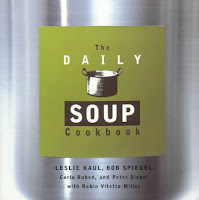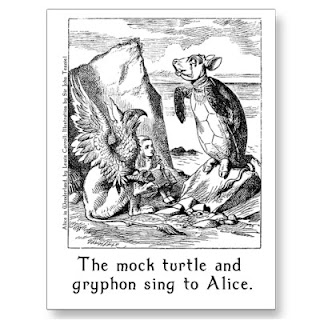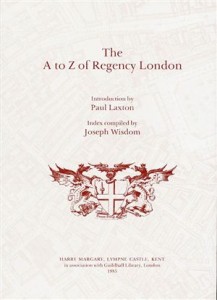 One of the challenges of writing a Regency Romance is geography. I know. Not what you thought, is it? Well, it’s one of my challenges. I want my characters to be taking the correct streets, catching the mail coach at the right inn, taking a walk along the right path in the right park, running off the road into the right ditch.
One of the challenges of writing a Regency Romance is geography. I know. Not what you thought, is it? Well, it’s one of my challenges. I want my characters to be taking the correct streets, catching the mail coach at the right inn, taking a walk along the right path in the right park, running off the road into the right ditch.
It’s not always easy to make this happen and I’m never quite sure I’ve got it right but I have certain go-to books that help me get around the Regency without taking a totally wrong turn.
My current WIP takes place mostly in London. This at least puts some boundaries around my geographical exploration. When negotiating the byways of Regency London, I always start with The A to Z of Regency London. This fabulous book was published by the London Topographical Society in 1985 and is based on Richard Horwood’s map (third edition, 1813). But it is far more useful than Horwood’s huge map (which requires really good eyesight and a magnifying glass). The Horwood map is broken into 40 sections and enlarged. And each street, square, lane, almshouse, burial ground (and more) is indexed. If you want to know where anything is in Regency London and its relative position this is your resource. It will, without a doubt, help you get your heroine from Little Brooke Street to Gunter’s for ices with nary a wrong turn.
Perhaps, you crave a little more detail. I wanted to send my hero and heroine meandering through a park and needed more than a map to get the ambience right. London Green by Neville Braybooke has a pretty good overview of KensingtonGardens, Hyde Park, GreenPark, and St. James Park. You have to be a little careful with Neville, here, as it’s not quite as era-specific as one would want, but it has some great illustrations, history and enough detail to probably extract what you need for a romantic stroll.
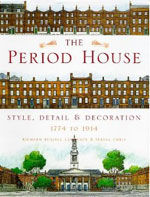 It’s not all geography, though. If you have a burning need to be able to talk, in detail, about the design of your hero’s townhouse, you might want to take a peek at Georgian London by John Summerson. This lovely book is probably going to give you more information that you’ll ever need and maybe should be reserved for the day when you really want a thorough background on the architecture of the city. For the basics, I really recommend The Period House: Style, Detail & Decoration 1774-1914, a good, general overview of several different types of townhouses complete with floorplans. This book will allow you to move your heroine from her room to the library (with a candle, in her nightclothes) without having her stray into the kitchen.
It’s not all geography, though. If you have a burning need to be able to talk, in detail, about the design of your hero’s townhouse, you might want to take a peek at Georgian London by John Summerson. This lovely book is probably going to give you more information that you’ll ever need and maybe should be reserved for the day when you really want a thorough background on the architecture of the city. For the basics, I really recommend The Period House: Style, Detail & Decoration 1774-1914, a good, general overview of several different types of townhouses complete with floorplans. This book will allow you to move your heroine from her room to the library (with a candle, in her nightclothes) without having her stray into the kitchen.
 Just a couple of more. Your hero, undoubtedly needs a place to escape from his meddling mama. You’ll need to send him to his club. Also, you’ll need to know what club to send him to. Try The Gentlemen’s Clubs of London. This is also not era-specific, but it has a brief history and description of each club and great photos. You’ll be able to find the right place for your boy to hide out and you’ll get a good picture of what it looks like. What more you do need?
Just a couple of more. Your hero, undoubtedly needs a place to escape from his meddling mama. You’ll need to send him to his club. Also, you’ll need to know what club to send him to. Try The Gentlemen’s Clubs of London. This is also not era-specific, but it has a brief history and description of each club and great photos. You’ll be able to find the right place for your boy to hide out and you’ll get a good picture of what it looks like. What more you do need?
How about a romantic evening? Vauxhall Gardens might be just the place. VauxhallGardens, A History has more information than you’ll ever need about this scene of many a seduction. Truly, it is more information than you’ll ever want unless you want your hero to build his own pleasure garden. Which, come to think of it, is an interesting idea.
 Let me leave you with one last, excellent, book for a general understanding of your era in London. Dan Cruickshank and Neil Burton’s Life in the Georgian City is both general and detailed. Dan Cruickshank makes the various parts of the Georgian city accessible to the reader. This book has chapters on street life, work and play, houses and their occupants, construction, interior design, gardens, and includes two case studies. This is something you might just want to read for pleasure.
Let me leave you with one last, excellent, book for a general understanding of your era in London. Dan Cruickshank and Neil Burton’s Life in the Georgian City is both general and detailed. Dan Cruickshank makes the various parts of the Georgian city accessible to the reader. This book has chapters on street life, work and play, houses and their occupants, construction, interior design, gardens, and includes two case studies. This is something you might just want to read for pleasure.
I have lots more. More on London, more on the countryside, more on getting from one to the other and what to do when you get there. I look forward to sharing my library with you this year.
Do you have a favorite research book or web site? What’s your go-to resource when you’re thinking about Regency England?
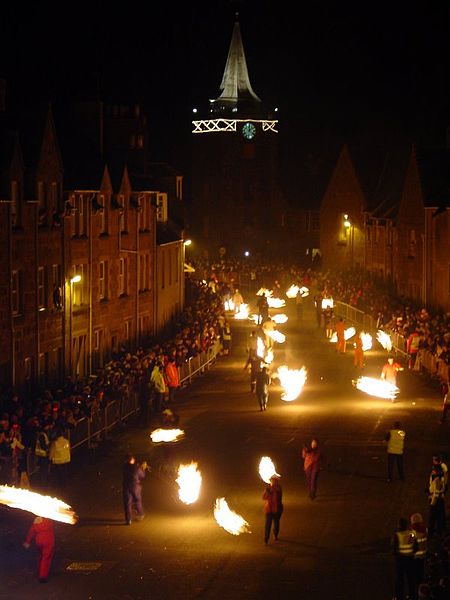 In Stonewall, each New Year’s Eve men parade down the streets swinging huge fireballs over their heads by wire or chains. Any fireballs left burning are flung into the harbor.
In Stonewall, each New Year’s Eve men parade down the streets swinging huge fireballs over their heads by wire or chains. Any fireballs left burning are flung into the harbor. A Viking longship is burned in Edinburgh harbor as part of that city’s days long celebration. And Edinburgh has a big fireworks display as well.
A Viking longship is burned in Edinburgh harbor as part of that city’s days long celebration. And Edinburgh has a big fireworks display as well.
 One of the challenges of writing a Regency Romance is geography. I know. Not what you thought, is it? Well, it’s one of my challenges. I want my characters to be taking the correct streets, catching the mail coach at the right inn, taking a walk along the right path in the right park, running off the road into the right ditch.
One of the challenges of writing a Regency Romance is geography. I know. Not what you thought, is it? Well, it’s one of my challenges. I want my characters to be taking the correct streets, catching the mail coach at the right inn, taking a walk along the right path in the right park, running off the road into the right ditch. It’s not all geography, though. If you have a burning need to be able to talk, in detail, about the design of your hero’s townhouse, you might want to take a peek at
It’s not all geography, though. If you have a burning need to be able to talk, in detail, about the design of your hero’s townhouse, you might want to take a peek at  Just a couple of more. Your hero, undoubtedly needs a place to escape from his meddling mama. You’ll need to send him to his club. Also, you’ll need to know what club to send him to. Try The
Just a couple of more. Your hero, undoubtedly needs a place to escape from his meddling mama. You’ll need to send him to his club. Also, you’ll need to know what club to send him to. Try The  Let me leave you with one last, excellent, book for a general understanding of your era in London. Dan Cruickshank and Neil Burton’s
Let me leave you with one last, excellent, book for a general understanding of your era in London. Dan Cruickshank and Neil Burton’s 
